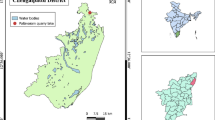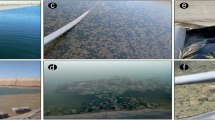Abstract
The structural features of a cyanobacterial mat from Lake Khilganta (Southeastern Transbaikal Region) developing at different values of salinity and pH were determined based on our long-term investigation of the natural community, as well as results obtained during experimentation with its laboratory analogue. At water mineralization of 40–50 g/l, Microcoleus chthonoplastes and Phormidium molle play a key role in the formation of the cyanobacterial mat. As water mineralization increases, the diversity of cyanobacteria in the natural mat increases as well, reaches its maximum at 80 g/l NaCl, and decreases at 100 g/l. In the laboratory community, Nodularia sp. prevailed. It was able to form matlike structures within a broad pH range and at a salinity of up to 50 g/l NaCl. As the water mineralization level increased up to 100 g/l or higher, a replacement of the dominant complexes occurred both in the laboratory and natural communities: cyanobacterial species were substituted with green algae.
Similar content being viewed by others
References
Transbaikalian Soda Lakes. Ecology and Productivity. Lokot’, L.I. et al., Eds., Novosibirsk: “Nauka”, SO, 1991.
Dzyuba, A.A., Mineral Lakes, Geogr. Prir. Resur., 2002, no. 2, pp. 61–67.
Namsaraev, B.B. and Namsaraev, Z.B., Microbial Processes of the Carbon Cycle and Environmental Conditions in the Transbaikalian and Mongolian Alkaline Lakes. Proc. Winogradsky Inst. Microbiol., Vol. 14. Alkaliphilic Microbial Communities, Gal’chenko, V.F., Ed., Moscow: Nauka, 2007, pp. 299–322.
Gerasimenko, L.M., Mityushina, L.L., and Namsaraev, B.B., Microcoleus Mats from Alkaliphilic and Halophilic Communities, Mikrobiologiya, 2003, vol. 72, no. 1, pp. 84–92 [Microbiology (Engl. Transl.), vol. 72, no. 1, pp. 71–79].
Kompantseva, E.I., Sorokin, D.Yu., Gorlenko, V.M., and Namsaraev, B.B., The Phototrophic Community Found in Lake Khilganta (an Alkaline Saline Lake Located in the Southeastern Transbaikal Region), Mikrobiologiya, 2005, vol. 74, no. 3, pp. 410–419 [Microbiology (Engl. Transl.), vol. 74, no. 3, pp. 352–361].
Solonovatye i solenye ozera Zabaikal’ya: gidrokhimiya, biologiya (Brackish and Salt Lakes of the Transbaikal Region: Hydrochemistry and Biology), Namsaraev, B.B., Ed., Ulan-Ude: Buryat. State Univ., 2009.
Obyazov, V.A., Variations in Air Temperature and Humidity in the Transbaikalean Territiory and Adjacent Chinese Regions, in Prirodookhrannoe sotrudnichestvo Chitinskoi oblasti (Rossiiskaya Federatsiya) i avtonomnogo raiona vnutrennyaya Mongoliya (KNR) v transgranichnykh ekologicheskikh raionakh: materialy konferentsii, (Cooperation in Nature Preservation between the Chita Oblast (Russian Federation) and the Inner Mongolia Autonomous Region (PRC) in Transborder Ecological Regions: Proc. Conf.), Chita: Zabaikal. State Human.-Ped. Univ., 2007, pp. 247–250.
Namsaraev, Z.B., Gorlenko, V.M., Buryukhaev, S.P., Barkhutova, D.D., Dambaev, V.B., Dulov, E., Sorokin, V.V., and Namsaraev, B.B., Water Regime and Variations in Hydrochemical Characteristics of the Soda Salt Lake Khilganta (Southeastern Transbaikalia), Vodn. Resur., 2010, vol. 37, no. 4, pp. 477–483 [Water Resour. (Engl. Transl.), vol. 37, no. 4, pp 513–520].
Zavarzin, G.A., Orleanskii, V.K., Gerasimenko, L.M., Pushko, S.N., and Ushatinskaya, G.T., Laboratory Simulations of Cyanobacterial Mats of the Alkaline Geochemical Barrier, Mikrobiologiya, 2003, vol. 72, no. 1, pp. 93–98 [Microbiology (Engl. Transl.), vol. 72, no. 1, pp. 80–85].
Zabelina, M.N., Kiselev, I.A., Proshkina-Lavrenko, A.I., and Sheshukova, V.S., Diatomovye vodorosli (Diatoms), Moscow: Sov. nauka, 1951.
Dedusenko-Shchegoleva, N.T., Matvienko, A.M., and Shkorbatov, L.A., Zelenye vodorosli (Green Algae), Moscow: Akad. Nauk SSSR, 1959.
Moshkova, N.A. and Gollerbakh, M.M., Zelenye vodorosli (Green Algae), Leningrad: Nauka, 1986.
Palamar’-Mordvintseva, G.M., Zelenye vodorosli (Green Algae), Leningrad: Nauka, 1982.
Komárek, J. and Anagnostidis, K., Cyanoprokaryota 1. Teil: Chroococcales, in Süsswasserflora von Mitteleuropa, Ettl, H., Gärtner, G., Heynig, H., and Mollenhauer, D., Eds., Jena: G. Fischer, 1999, vol. 19/1.
Komárek, J. and Anagnostidis, K., Cyanoprokariota 2. Teil: Oscillatoriales, in Süsswasserflora von Mitteleuropa, Büdel, B., Gärtner, G., Krienitz, L., and Schagerl, M., Eds., 2007, vol. 19/2.
Gerasimenko, L.M., Alkaliphilic Oxygenic Phototrophic Organisms, in Trudy Instituta mikrobiologii imeni S.N. Vinogradskogo. Vyp. 14: Alkalofil’nye mikrobnye soobshchestva (Proc. Winogradsky Inst. Microbiol., vol. 14. Alkaliphilic Microbial Communities, Gal’chenko, V.F., Ed., Moscow: Nauka, 2007, pp. 88–157.
Author information
Authors and Affiliations
Corresponding author
Additional information
Original Russian Text © D.D. Tsyrenova, A.V. Bryanskaya, L.P. Kozyreva, Z.B. Namsaraev, B.B. Namsaraev, 2011, published in Mikrobiologiya, 2011, Vol. 80, No. 2, pp. 251–257.
Rights and permissions
About this article
Cite this article
Tsyrenova, D.D., Bryanskaya, A.V., Kozyreva, L.P. et al. Structure and formation properties of the haloalkaliphilic community of Lake Khilganta. Microbiology 80, 237–243 (2011). https://doi.org/10.1134/S0026261711020172
Received:
Published:
Issue Date:
DOI: https://doi.org/10.1134/S0026261711020172




